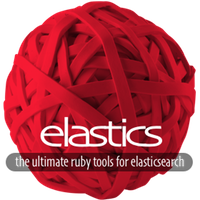
elastics-rails - Overview
The elastics-rails gem provides the engine and generators to integrate the elastics gems with Rails. It also loads the elastics-client, elastics-scopes and elastics-models gems, so you don’t have to explicitly include them in the Gemfile, unless you need to force some special version or commit. On the other hand you may want to add the elastics-admin gem which is optional.
Setup
1. Customize the Gemfile
Add the following to your Gemfile:
# use one of the following
# libcurl C based http client - faster
gem 'patron'
# pure ruby http client - more compatible
# gem 'rest-client'
gem 'elastics-rails'
# use elastics-admin if you need to dump/load/rename/live-reindex
# gem 'elastics-admin'Temporary Note: The
patrongem currently available on rubygem (v0.4.18) is missing the support for sending data with delete queries. As the result it fails with thedelete_by_queryelasticsearch API, when the query is the request body and not the param. If you want full support until a new version will be pushed to rubygems, you should usegem 'patron', :git => 'https://github.com/patron/patron.git'or switch to therest-clientgem.
2. Run bundle install
3. Run rails generate elastics:setup
That will install the needed files with comments and stubs.
Work Flow
1. Customize your models
Add the include Elastics::<some_model_module> to the model that need it (see elastics-models).
- Each time you include a
Elastics::ModelIndexerorElastics::ActiveModelyou should add its name to theconfig/initializers/elastics.rb - Each time you alter the way your models generate the source that will be indexed (for example by changing your
elastics_sourcemethods or adding/changing aelastics.parentrelation in a model) you should reindex your DB(s) (see Live Reindex)
2. Customize the config/initializers/elastics.rb
In this initializer you must add the elastics_models and/or elastics_active_models arrays. They are the names or the classes of the models that you customized with include Elastics::ModelIndexer or include Elastics::ActiveModel, and may want to customize other configuration variables. For example:
Elastics::Configuration.configure do |config|
config.elastics_models = %w[ Project ]
config.elastics_active_models = %w[ WebContent ]
config.result_extenders |= [YourResultExtenderA, YourResultExtenderB, ...]
config.variables.deep_merge! :index => 'test',
:type => 'project'
end(see Configuration)
3. Customize config/elastics.yml
This is an optional yaml file used to add custom mapping to your index or indices. You don’t need to use it unless you start to map your index/indices better. Elastics provides a quite detailed mapping by default, keeping into consideration all your indexed models and also parent/child relationships. Your file will be deep merged with the structure that Elastics will prepare on its own. You can inspect the mapping in the console with one of:
>> Elastics.get_mapping
>> Elastics.get_mapping :index => 'the_index', :type => nilWhile at it you can get info about the method and the usage of get_mapping by doing as usual:
>> Elastics.doc :get_mapping(see Self Documentation)
4. Run rake elastics:index:create or rake elastics:import
You sould use either rake elastics:index:create or rake elastics:import (if you already have data to index from your DB) in order to create a new index and its auto-generated mapping.
5. Customize the app/elastics/*
Usually contains your search classes (those that include any of Elastics::Templates, Elastics::ModelIndexer, etc.) and your Tempates Sources (see Template Sources). Average applications usually have just one class and one source template file but your mileage may vary. Here you can also add your Result Extenders modules (see Result Extenders), so keeping all the Elastics related files together.
Rails 3 and 4
Elastics comes with a Rails engine that integrates with your app very easily. The engine sets a few configuration defaults:
config.elastics.variables[:index]to your application’s underscored name, plus the currentRails.env(e.g.'my_app_development')config.elastics.config_filedefault path to"#{Rails.root}/config/elastics.yml"config.elastics.elastics_dirdefault path to"#{Rails.root}/app/elastics"config.elastics.logger.leveltoLogger::DEBUGin development mode (Logger::WARNotherwise)config.elastics.logger.log_to_rails_loggertotruefor the Rails server andfalsefor the Rails consoleconfig.elastics.logger.log_to_stderrtofalsefor the Rails server andtruefor the Rails consoleconfig.elastics.logger.debug_resulttotruefor the Rails server andfalsefor the Rails console
(see Configuration)
Per Environment Configuration
You might want to have different configuration settings for different environments. You can do so by using the config.elastics object in the environment file, for example:
config.elastics.http_client = Elastics::HttpClients::RestClient
config.elastics.http_client.base_uri = 'http://localhost:9400'Rails 2
You can use Elastics with Rails 2 applications as well, just remember that you should require elastics-rails so it will set the config_file and elastics_dir paths for you (see Configuration), but remember that the default config.elastics.variables[:index] variable and the config.elastics.app_id for Rails 2 are not set so you better configure them, somewhere. Also remember that you should explicitly call Elastics::Rails::Helper.after_initialize to complete the rails integration. Except this little difference in the configuration, there is no other difference from Rails 3 and 4.
